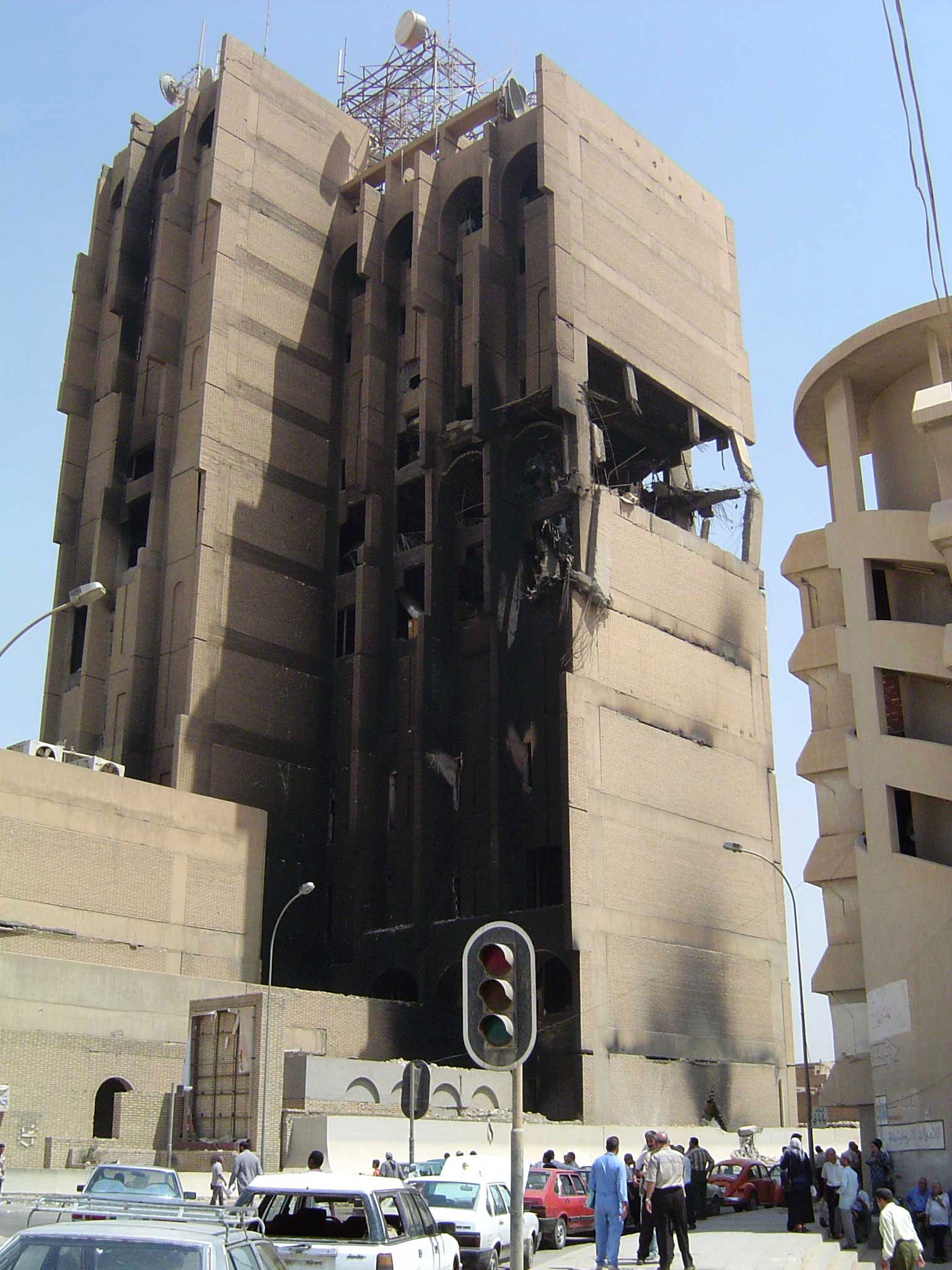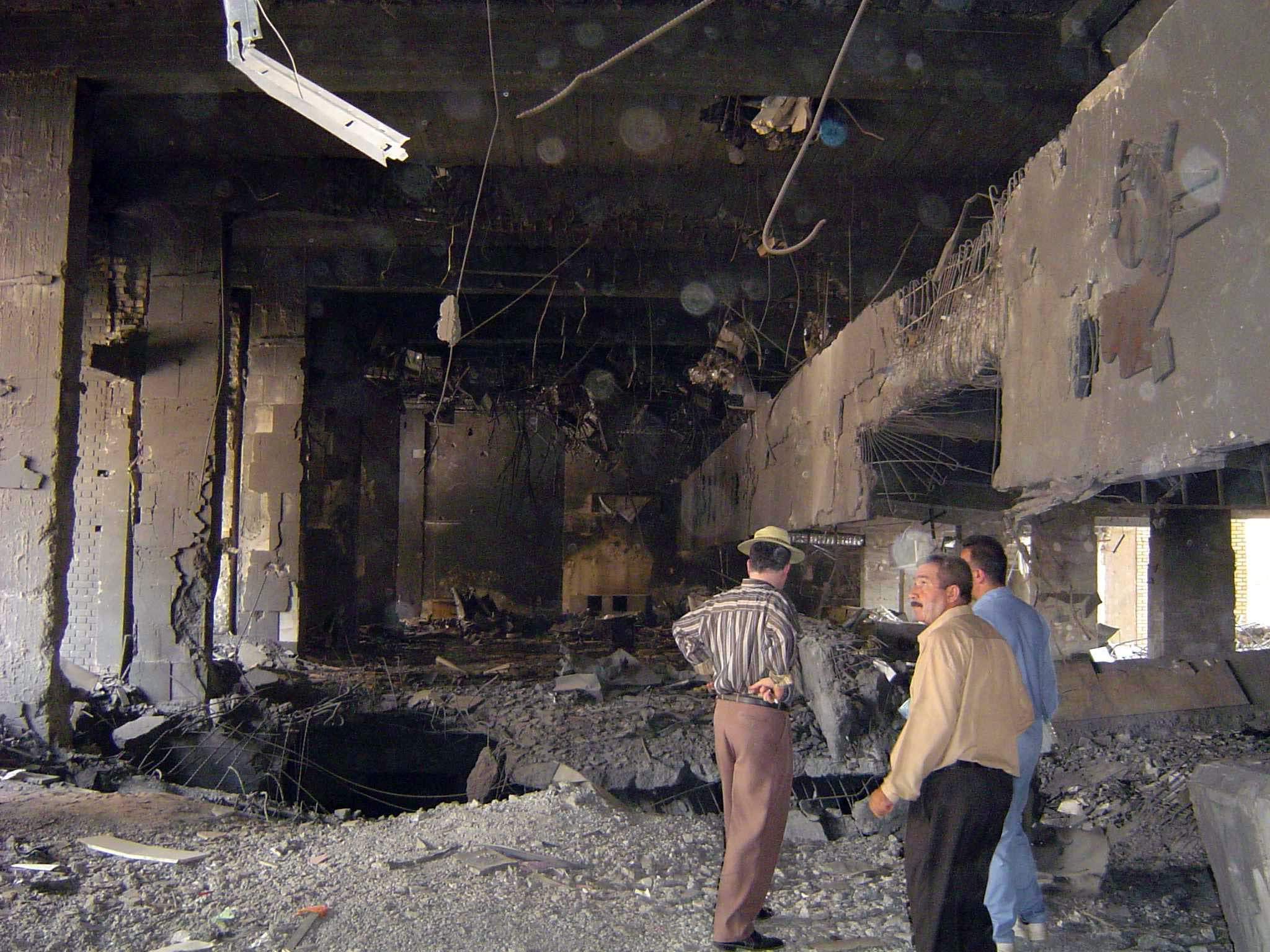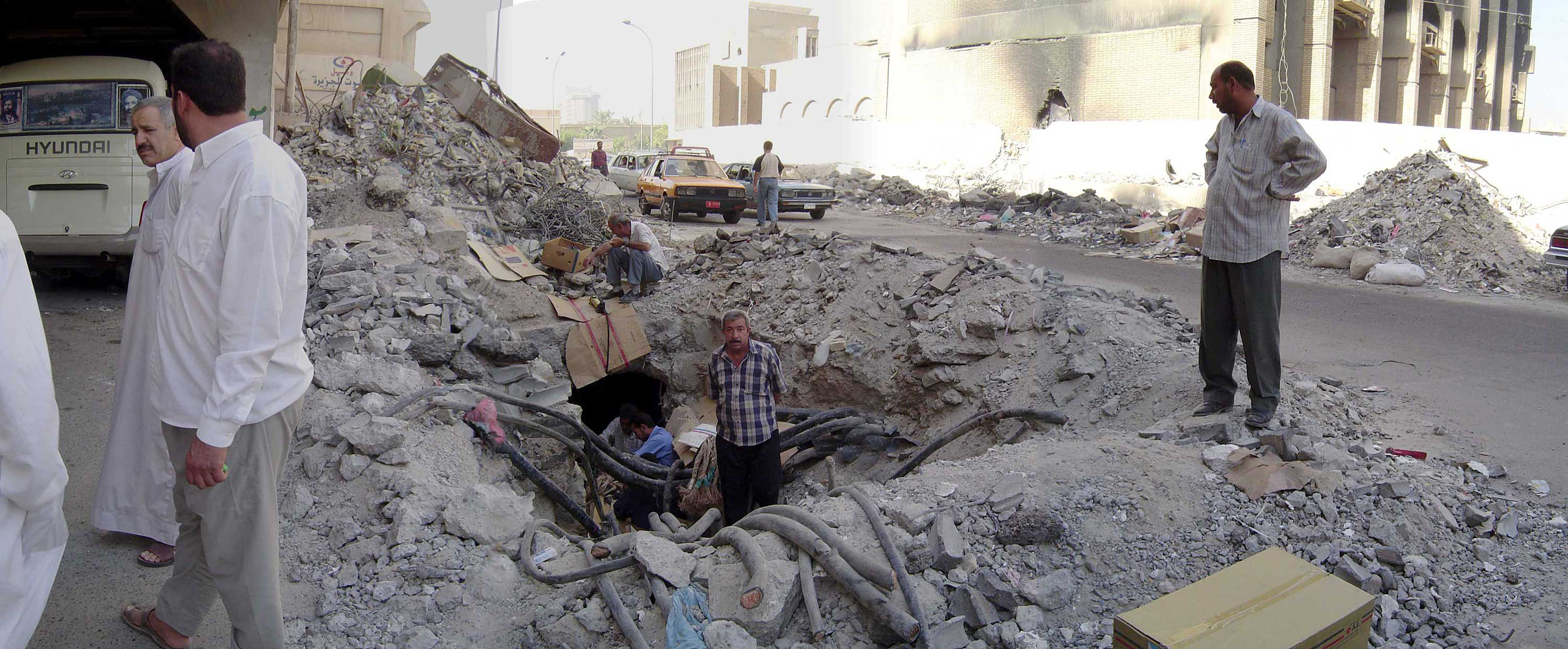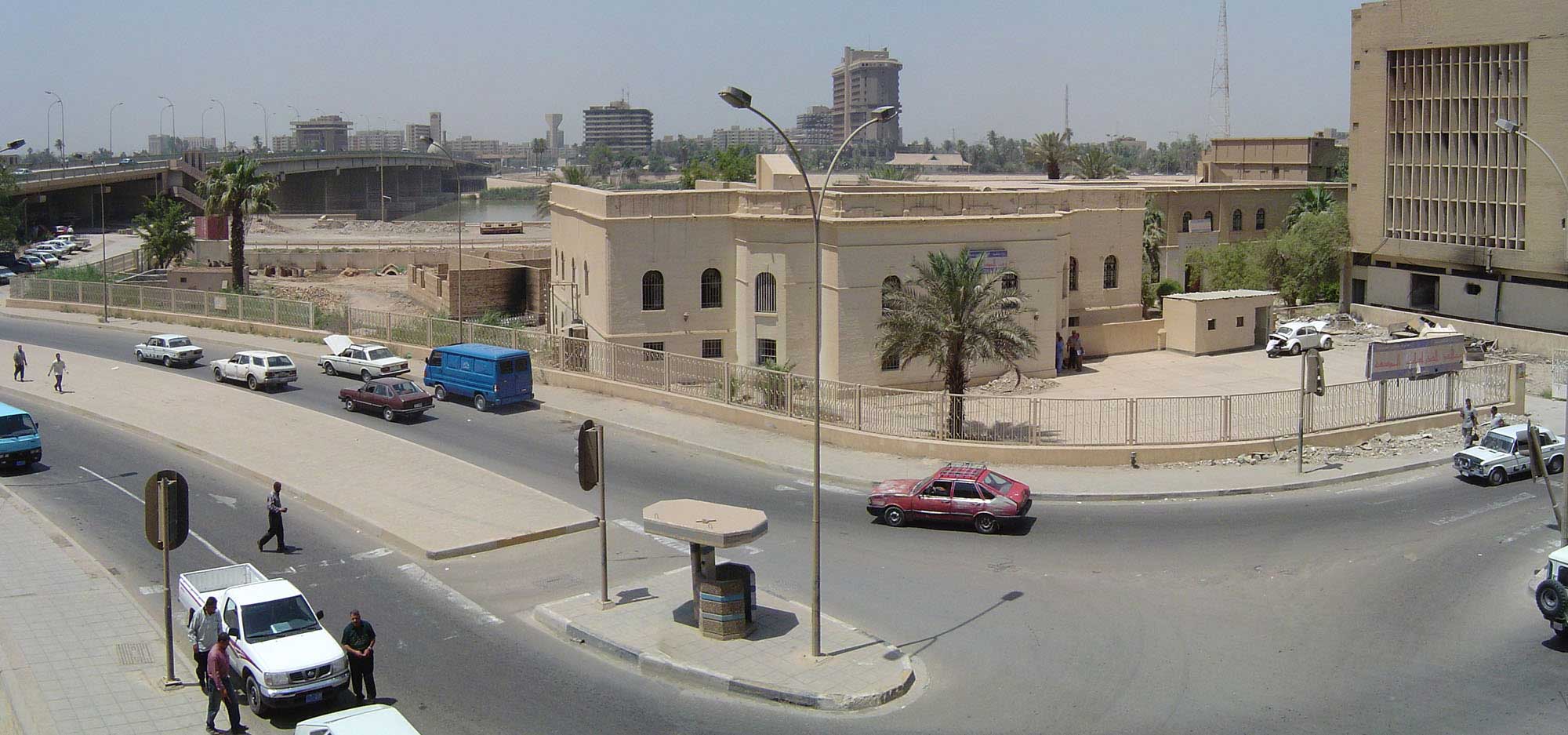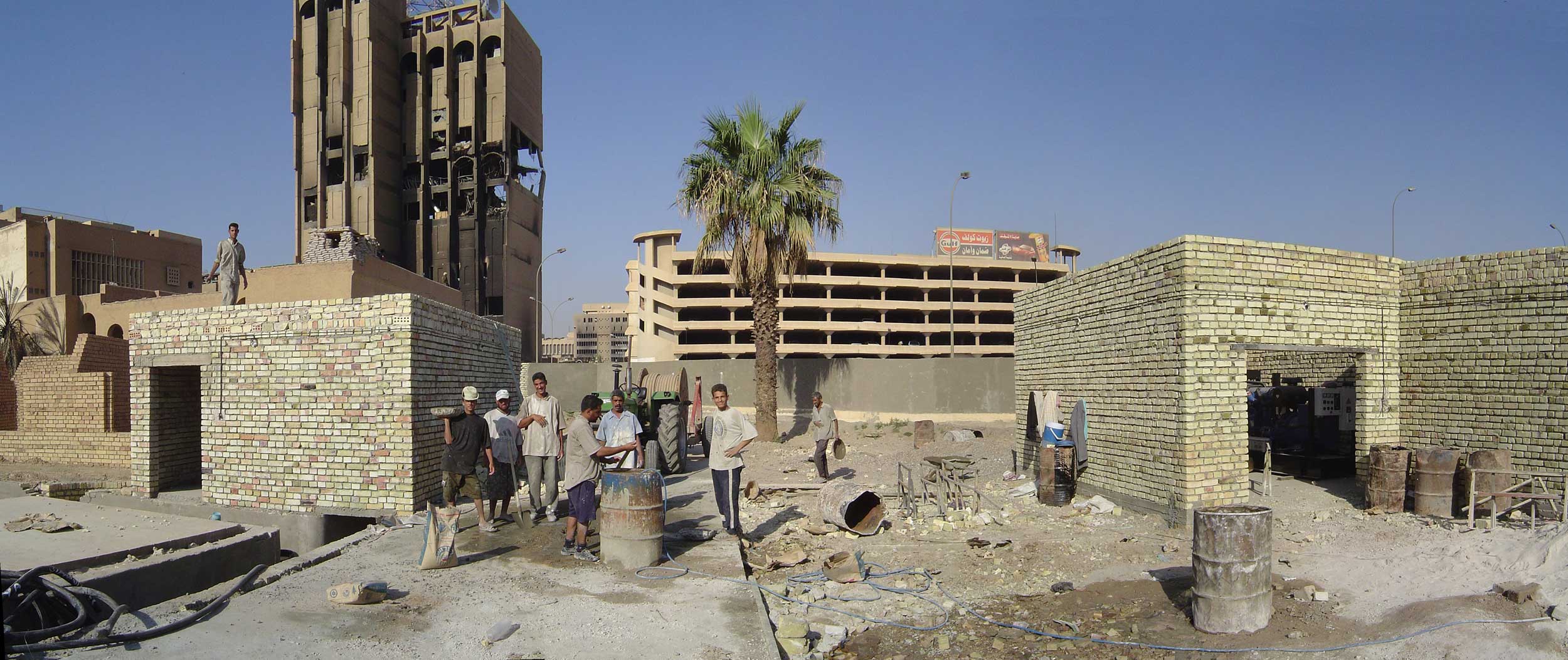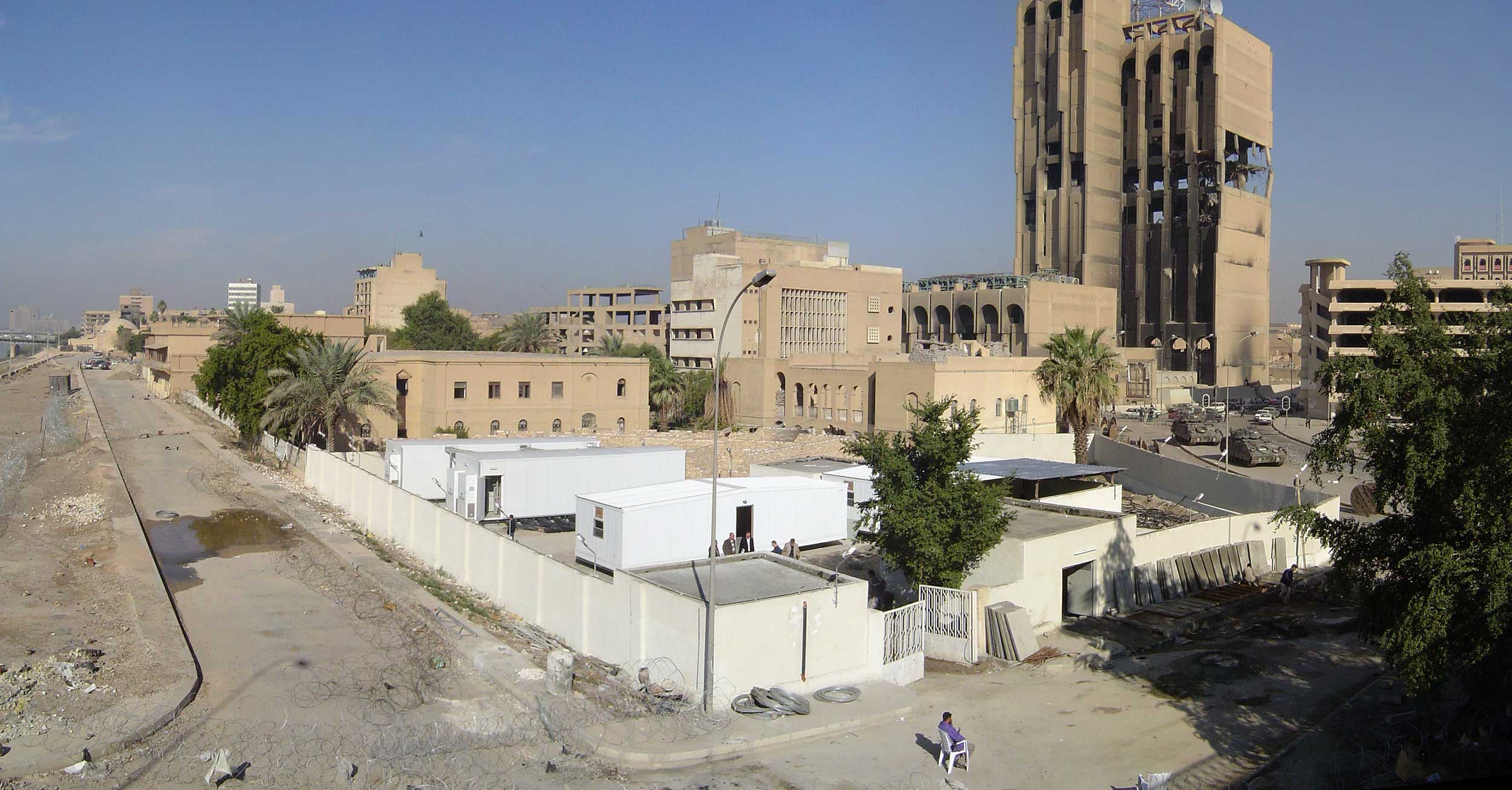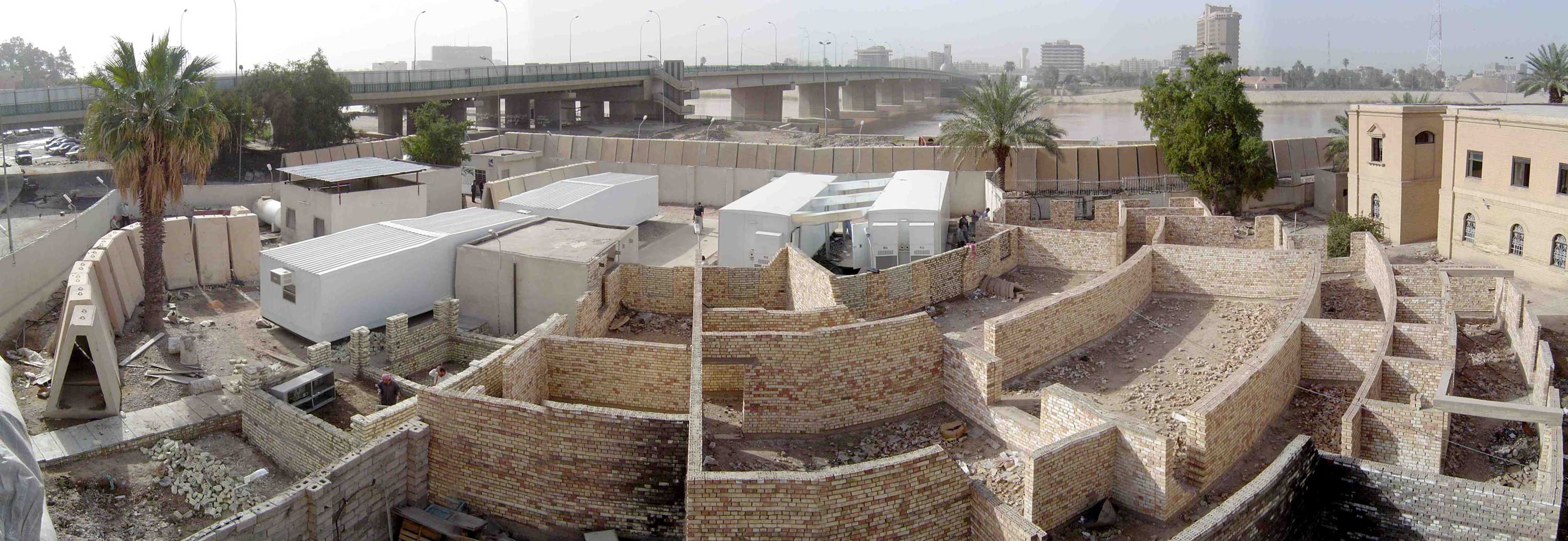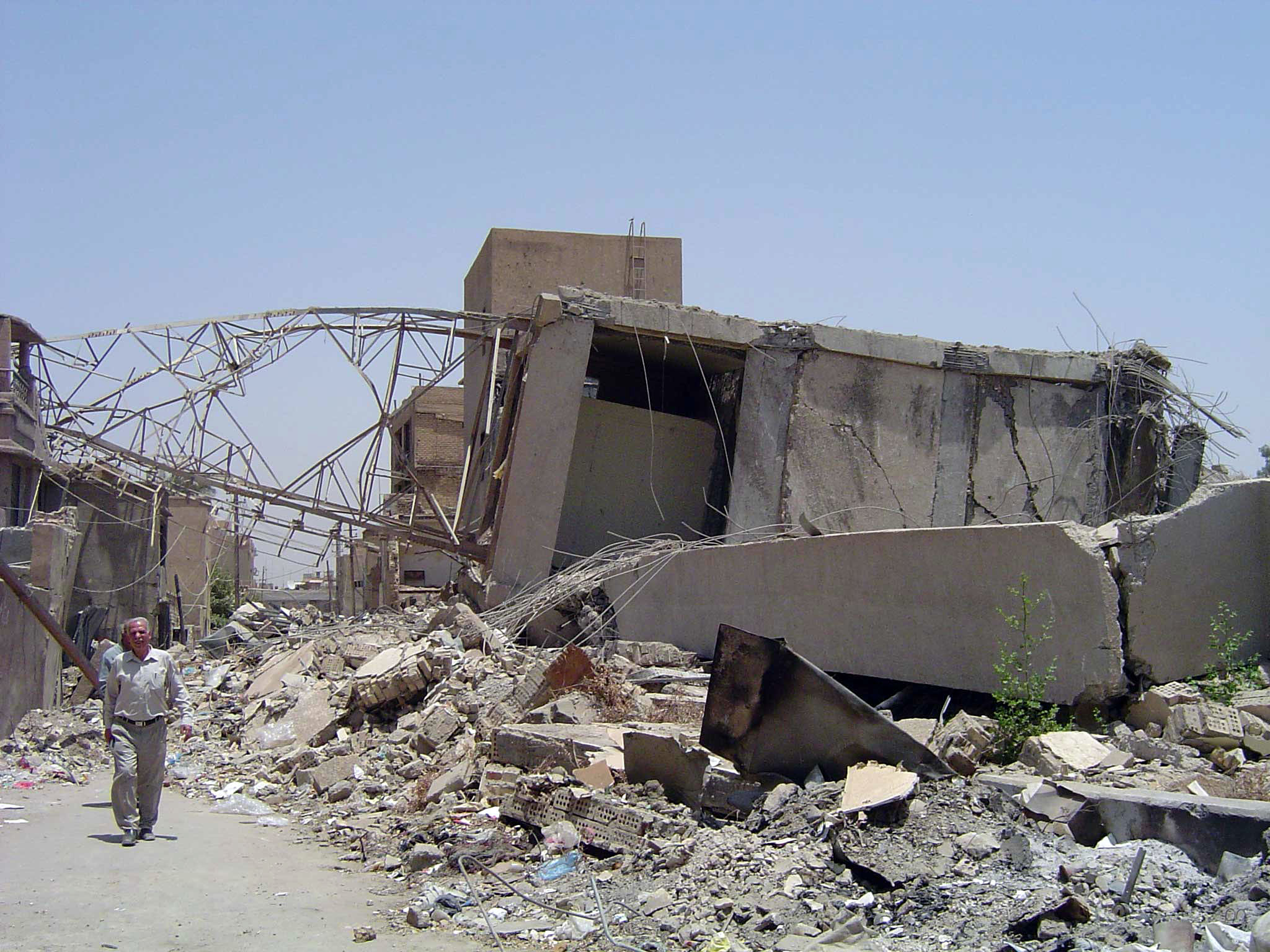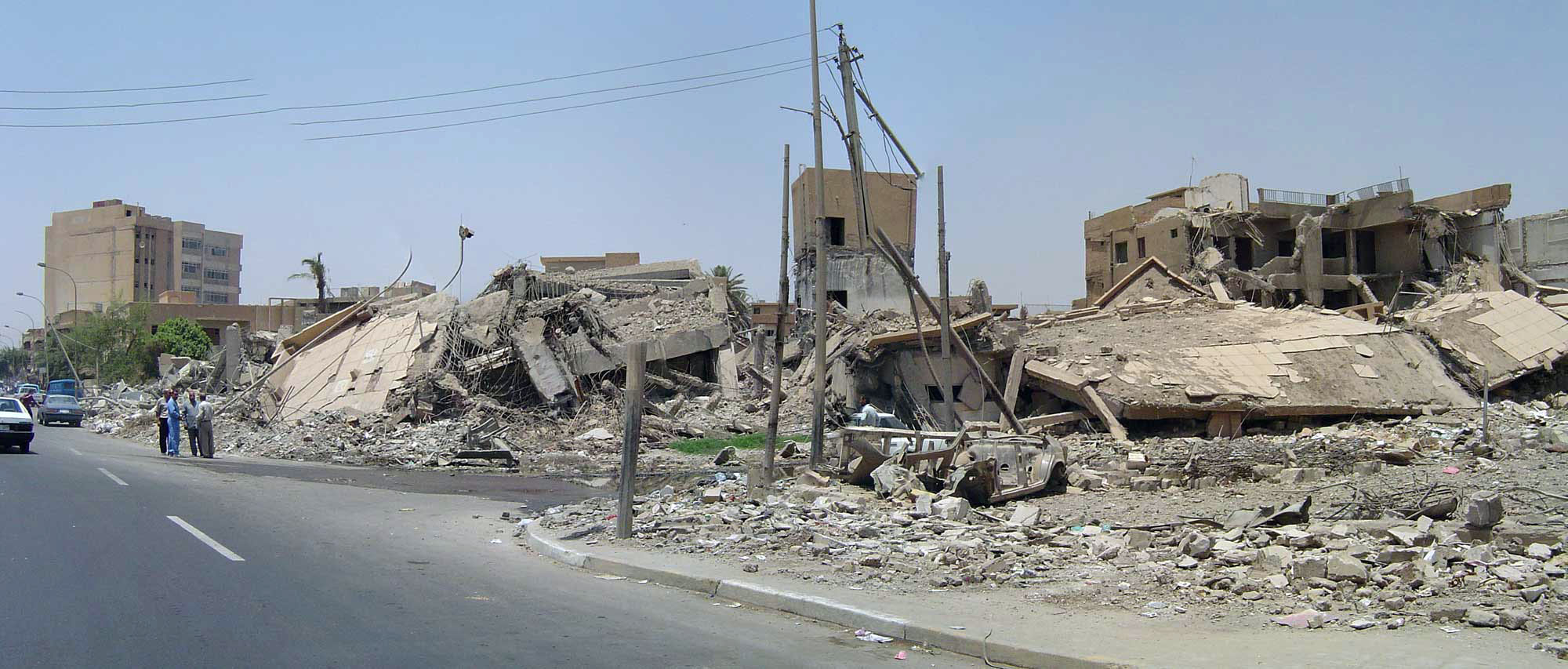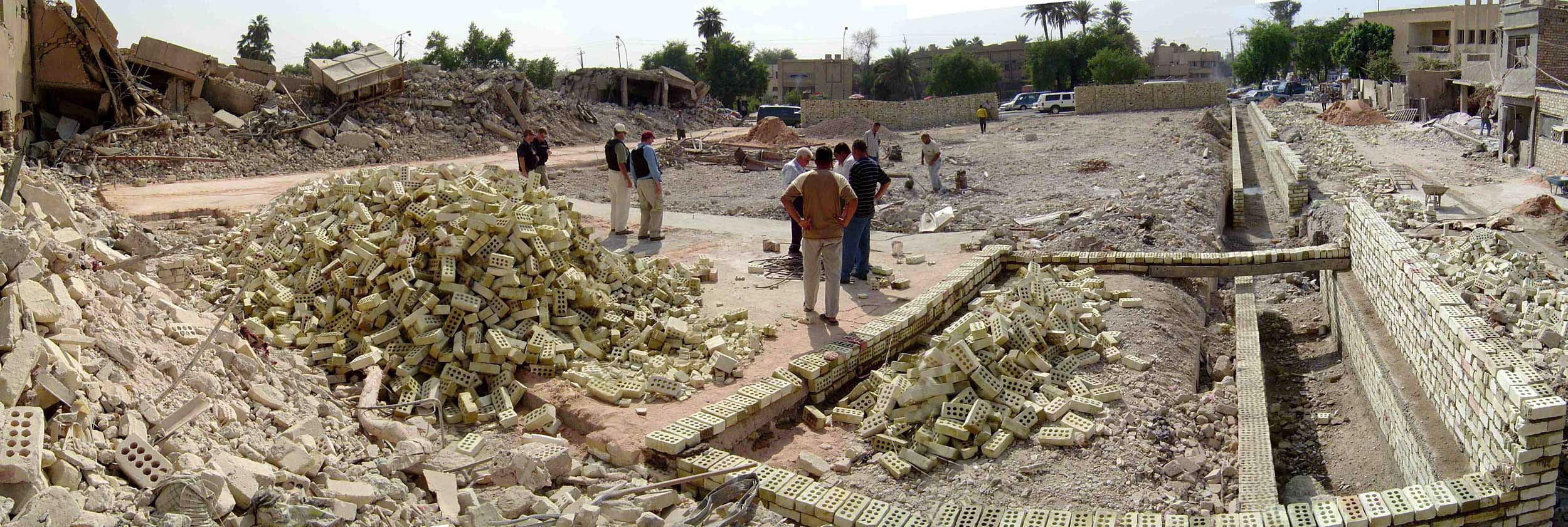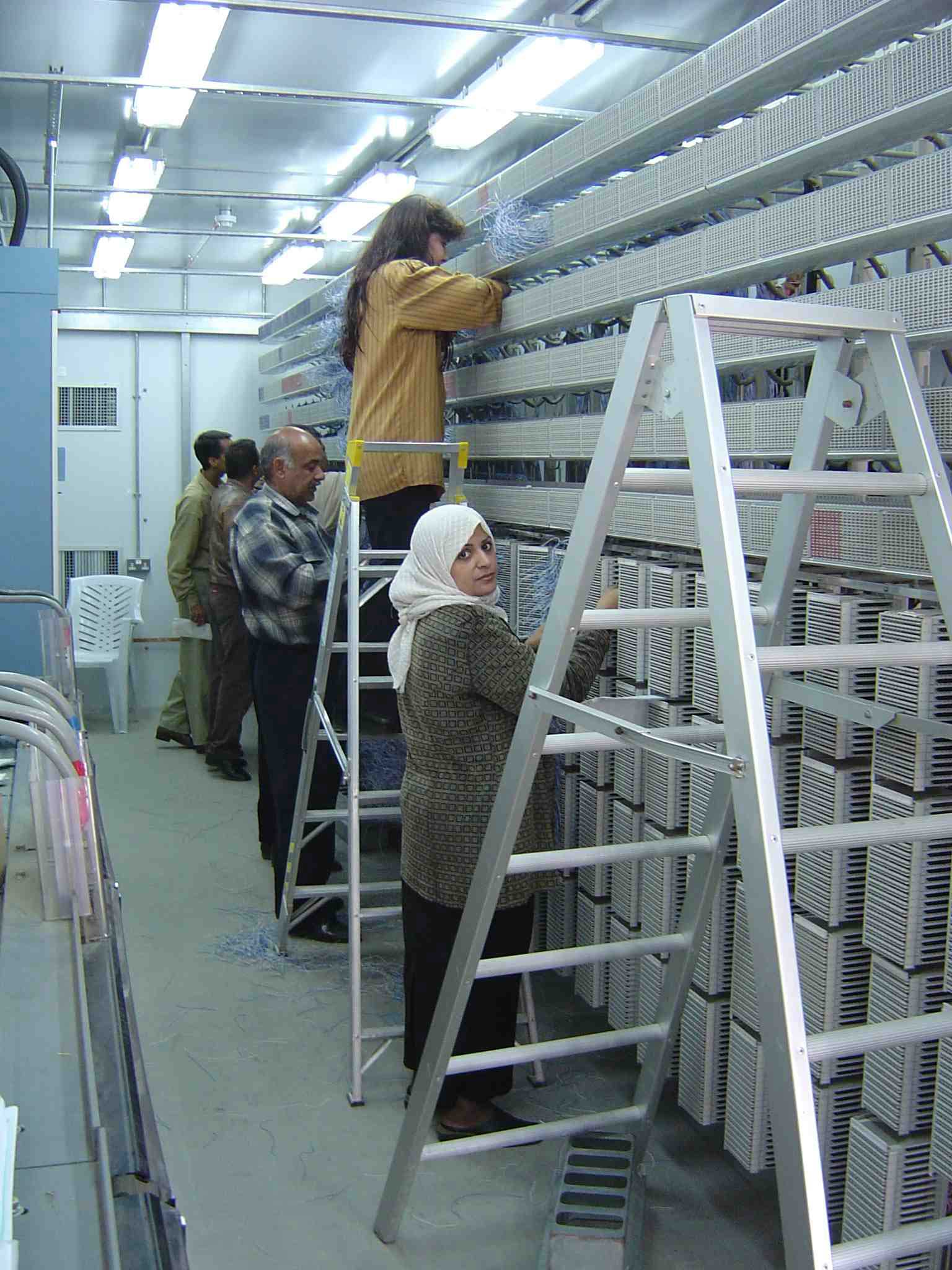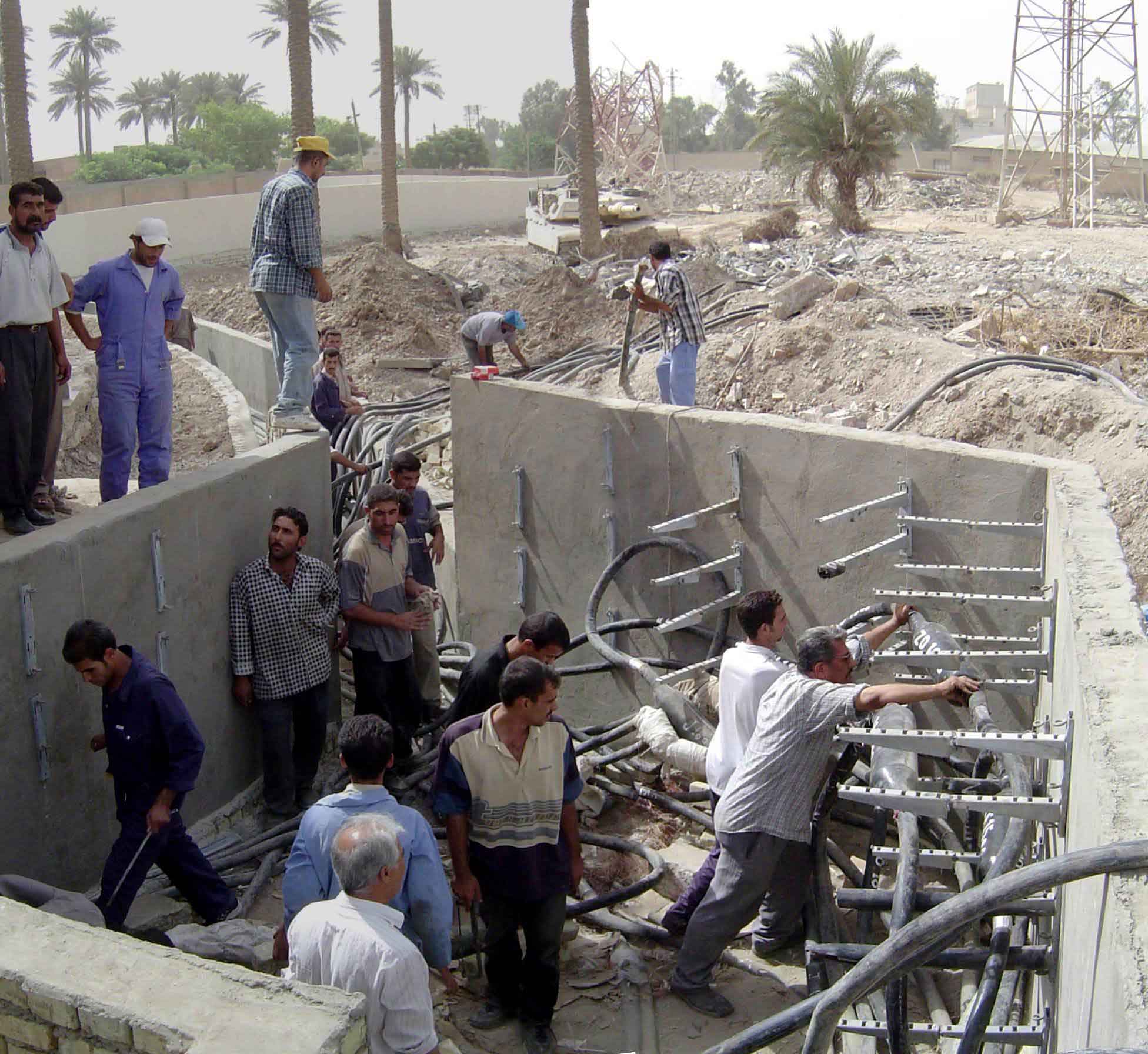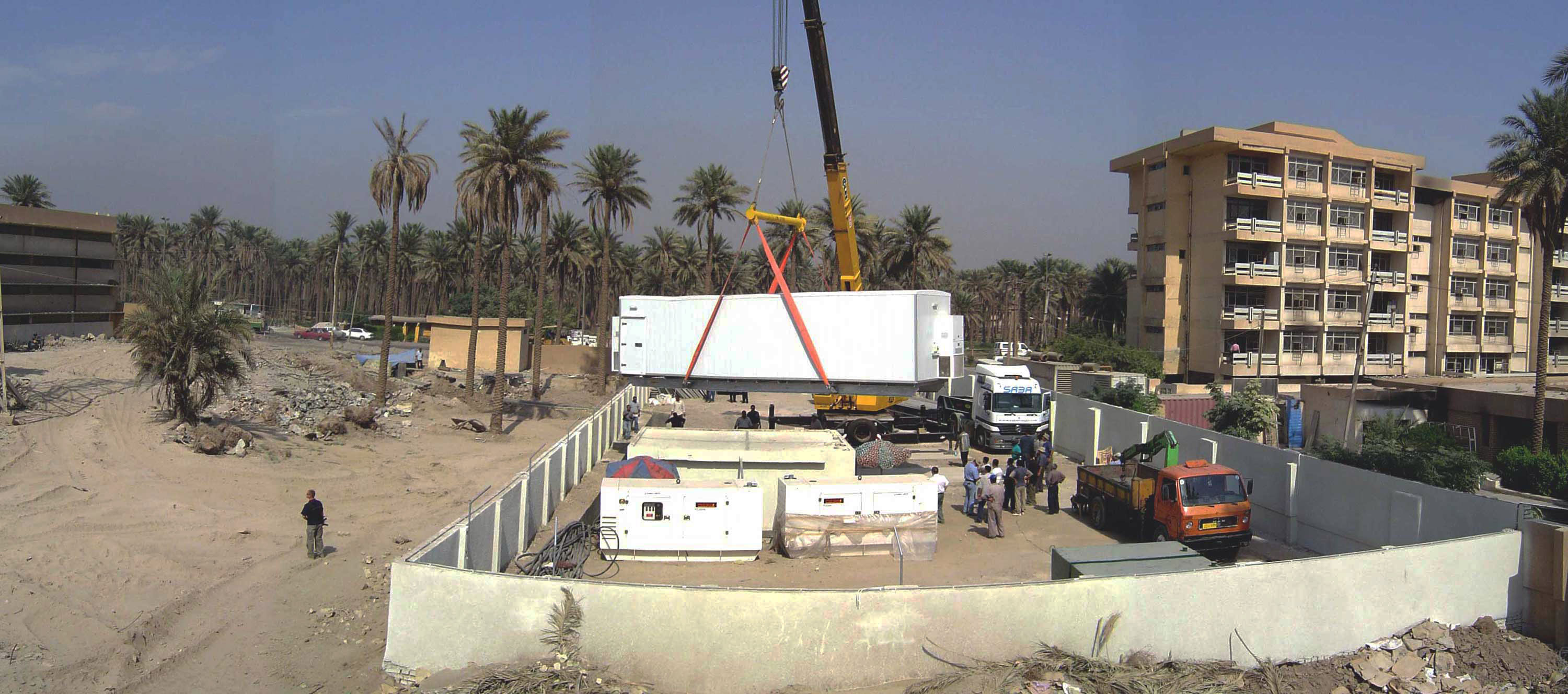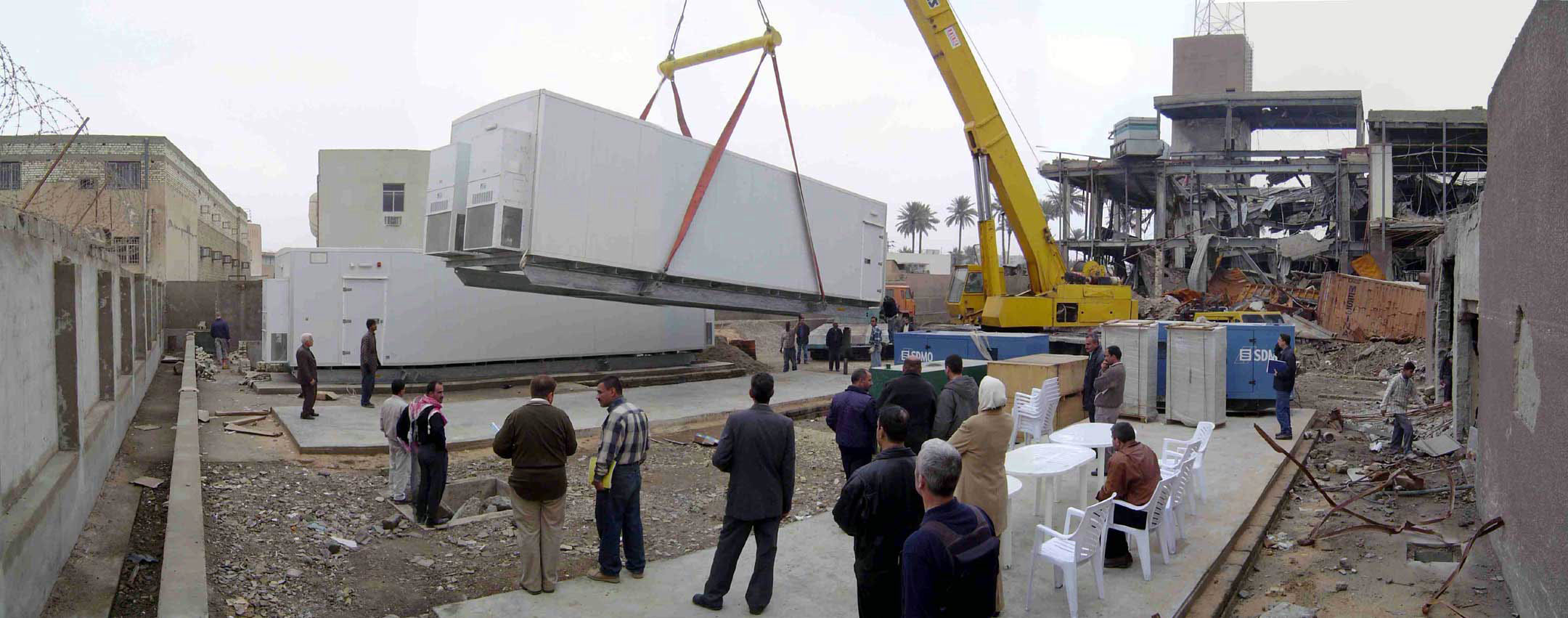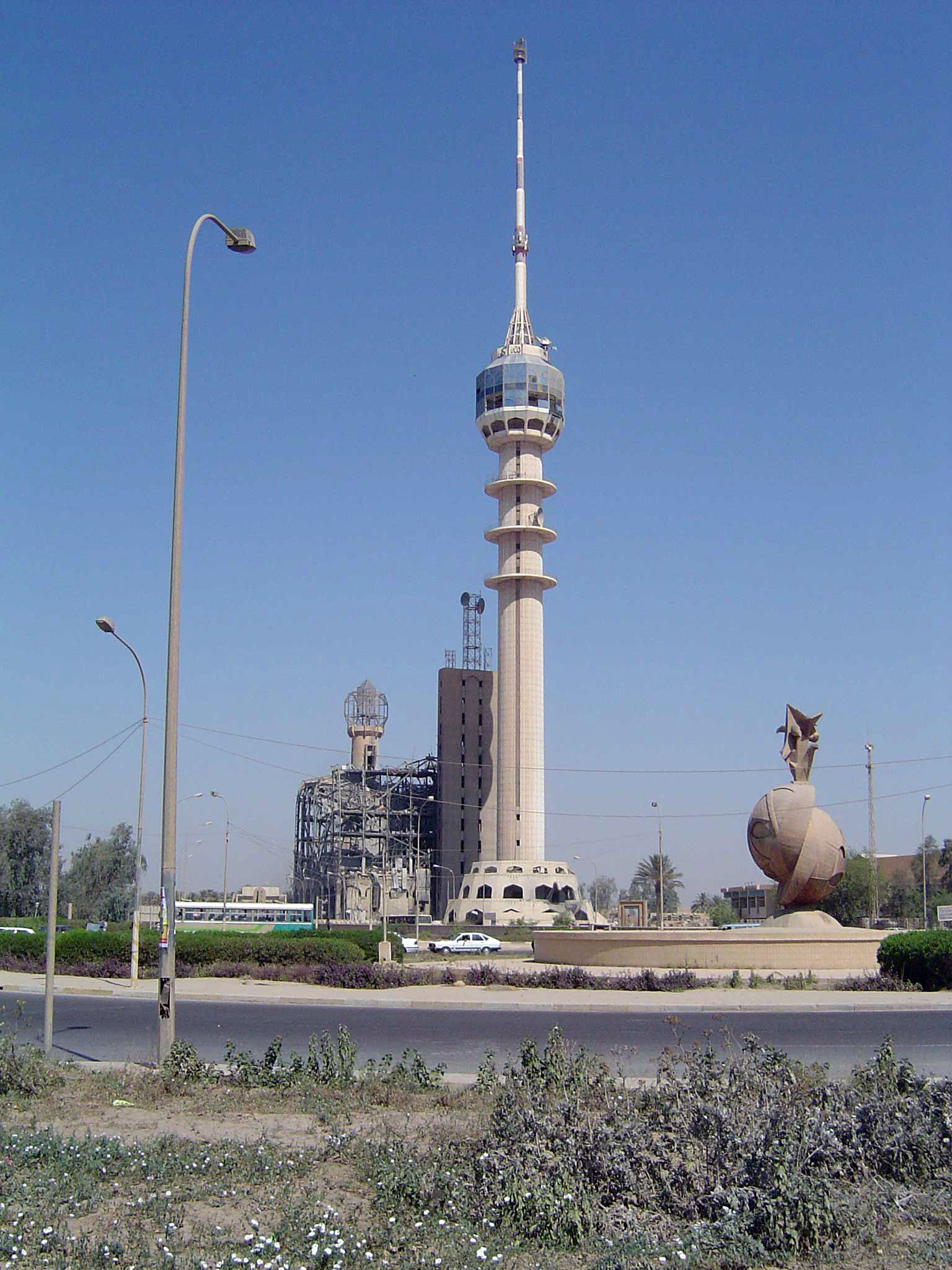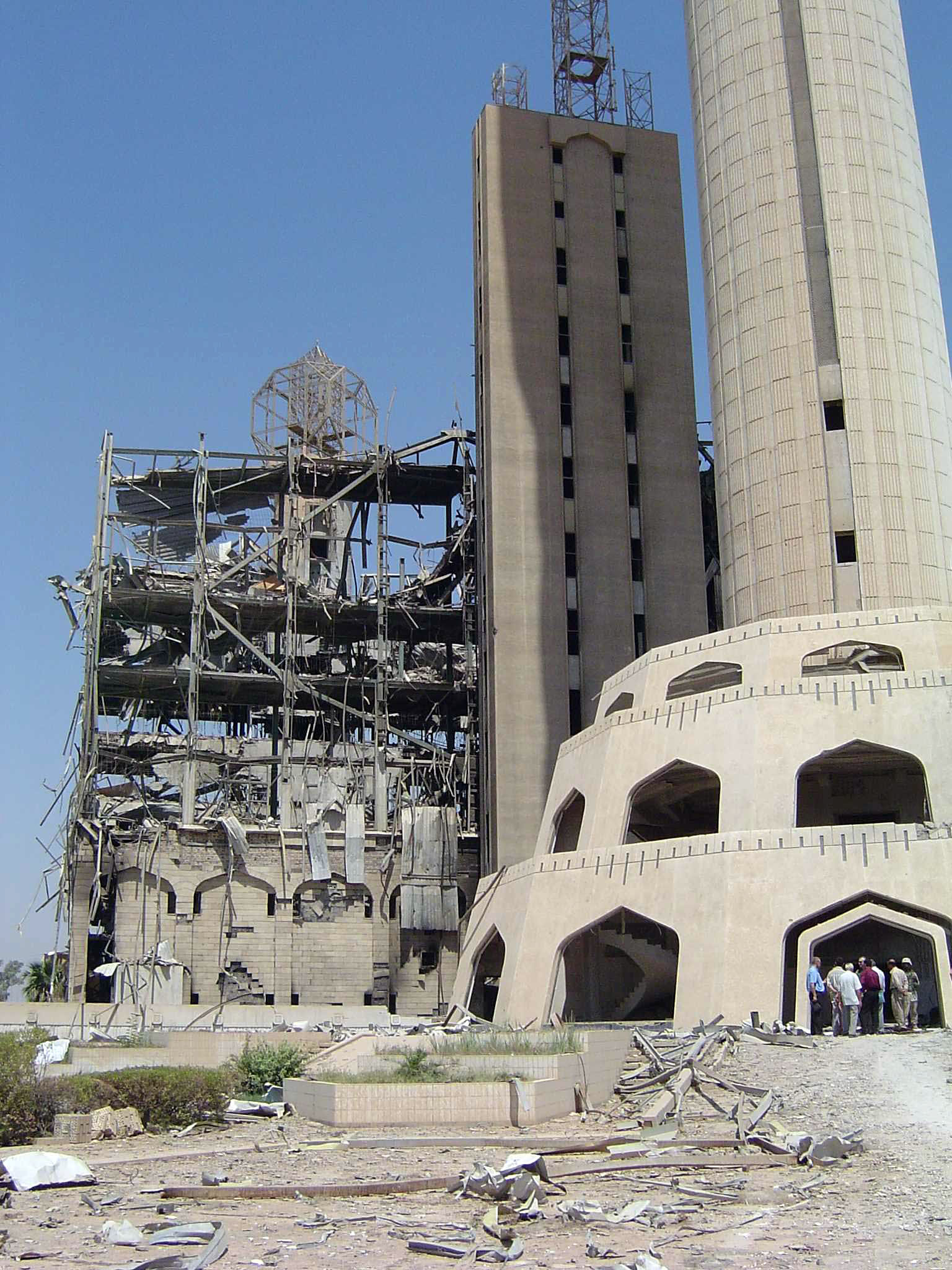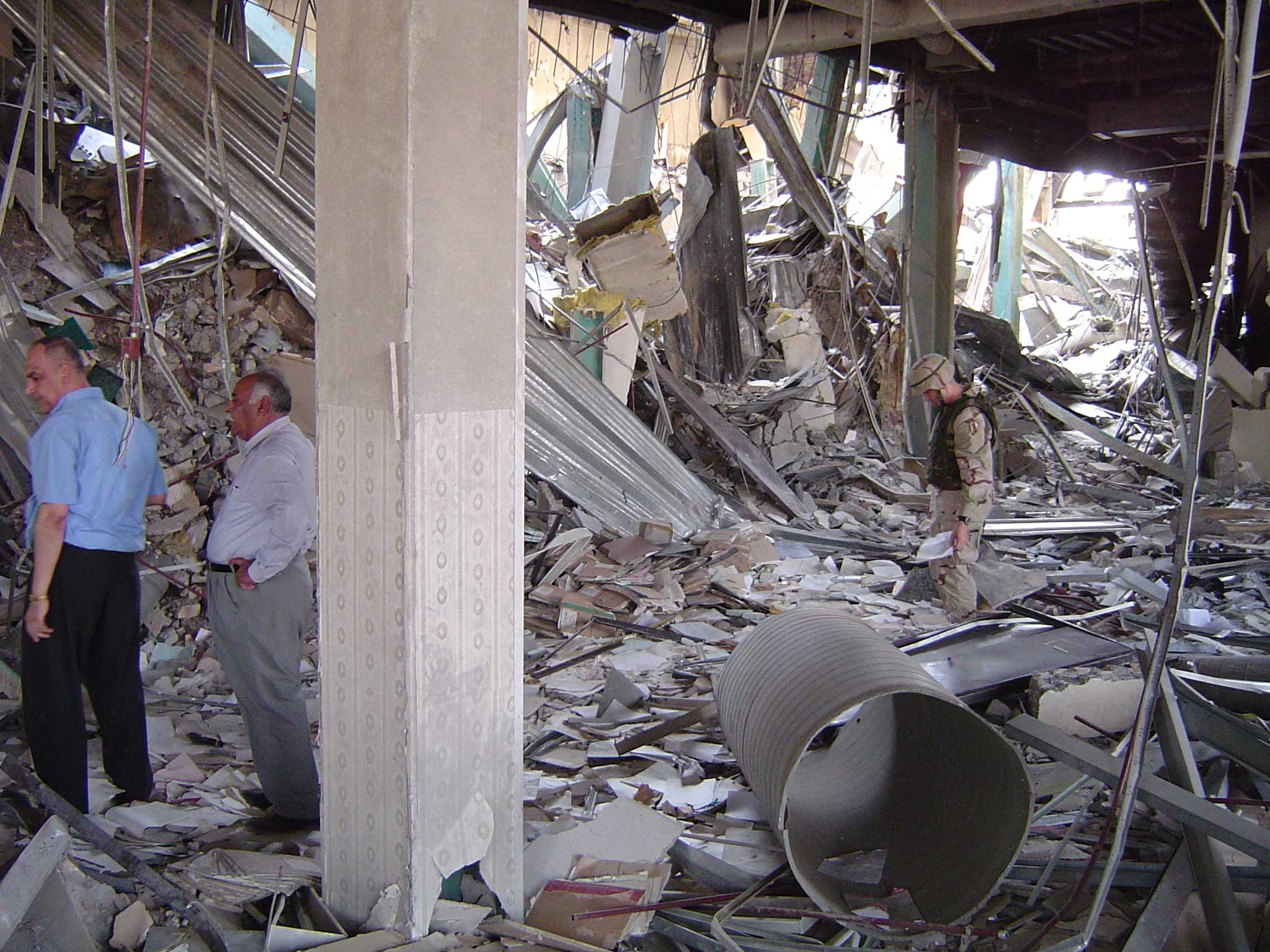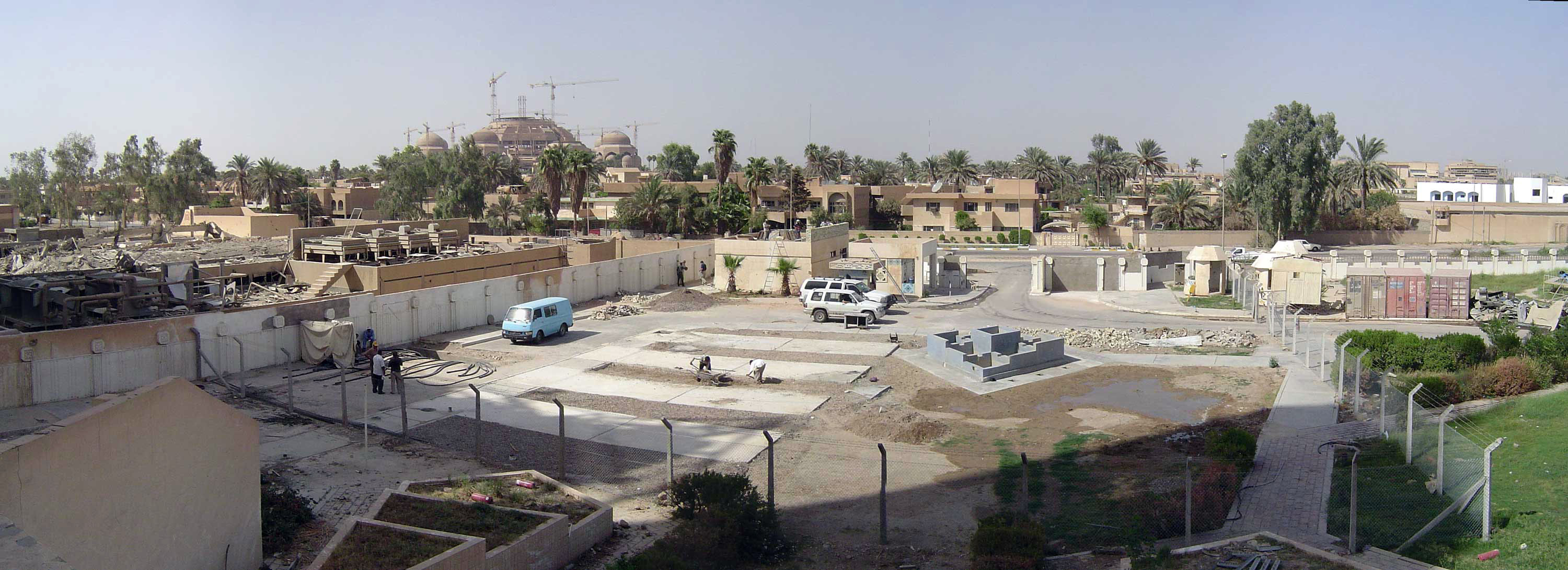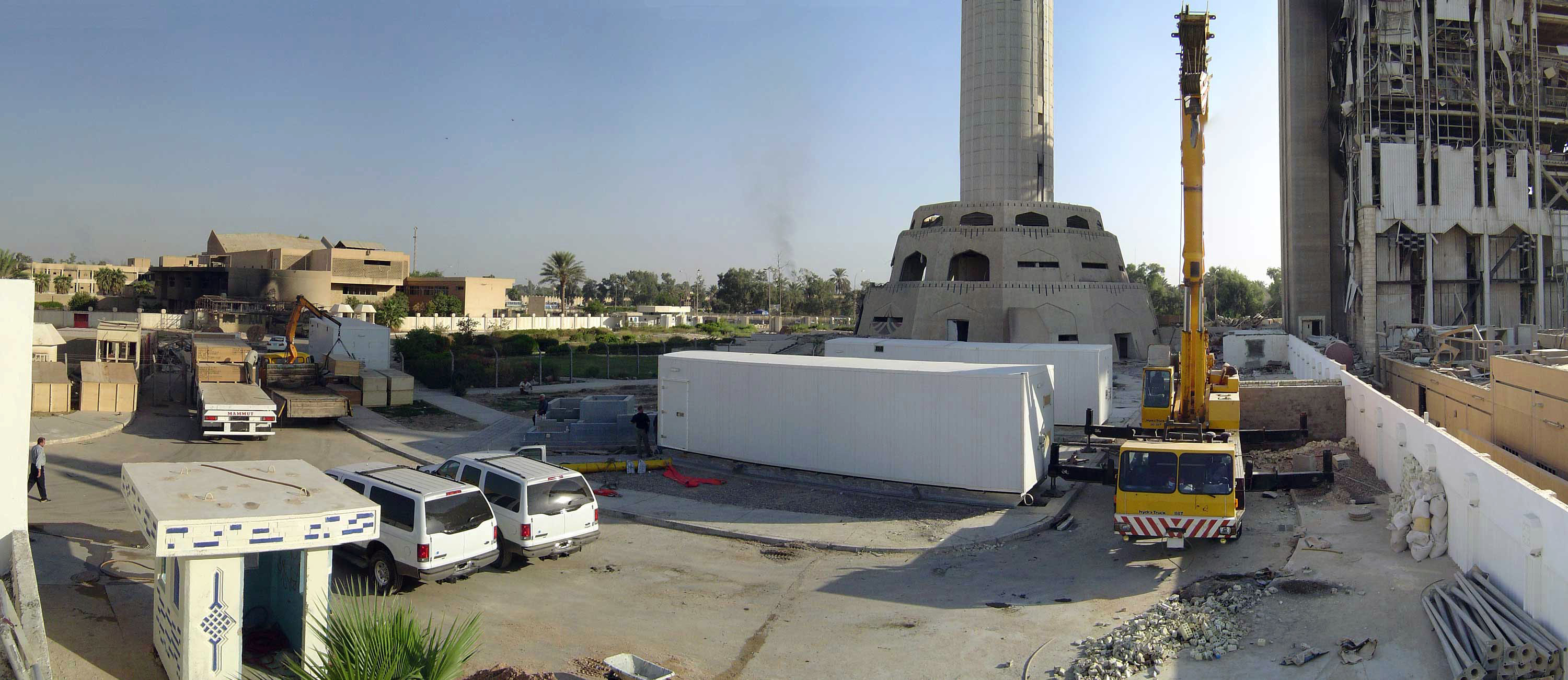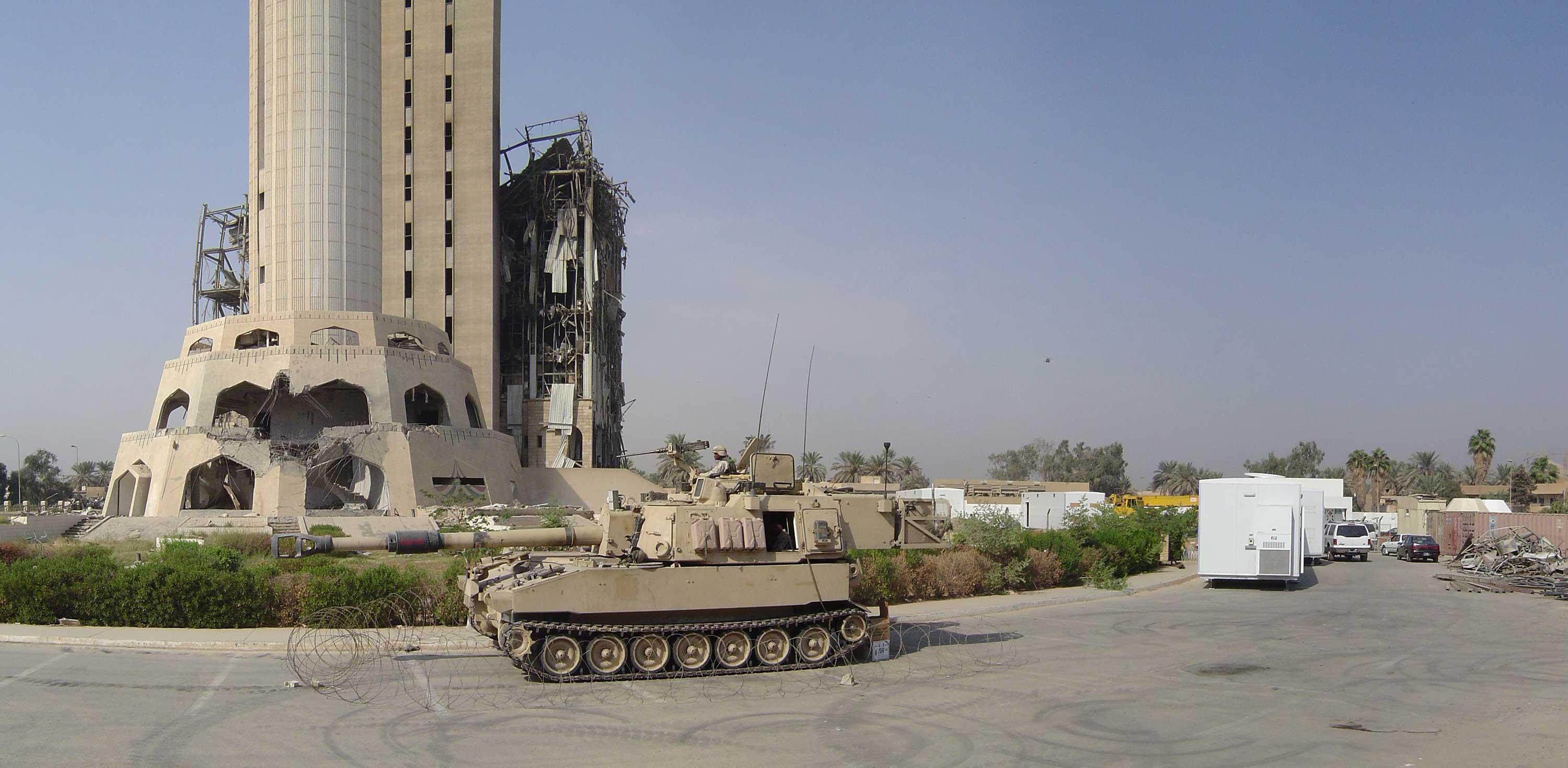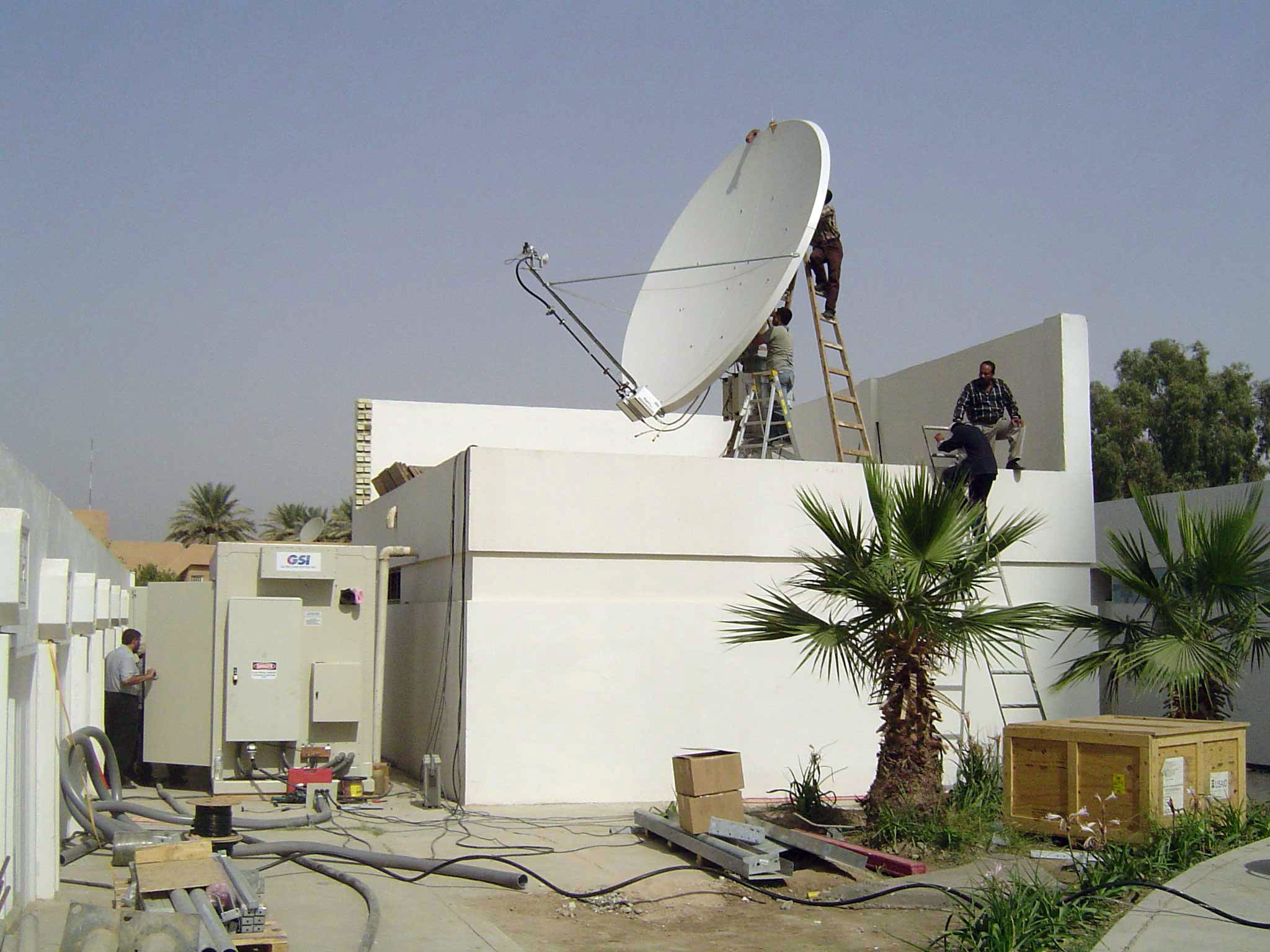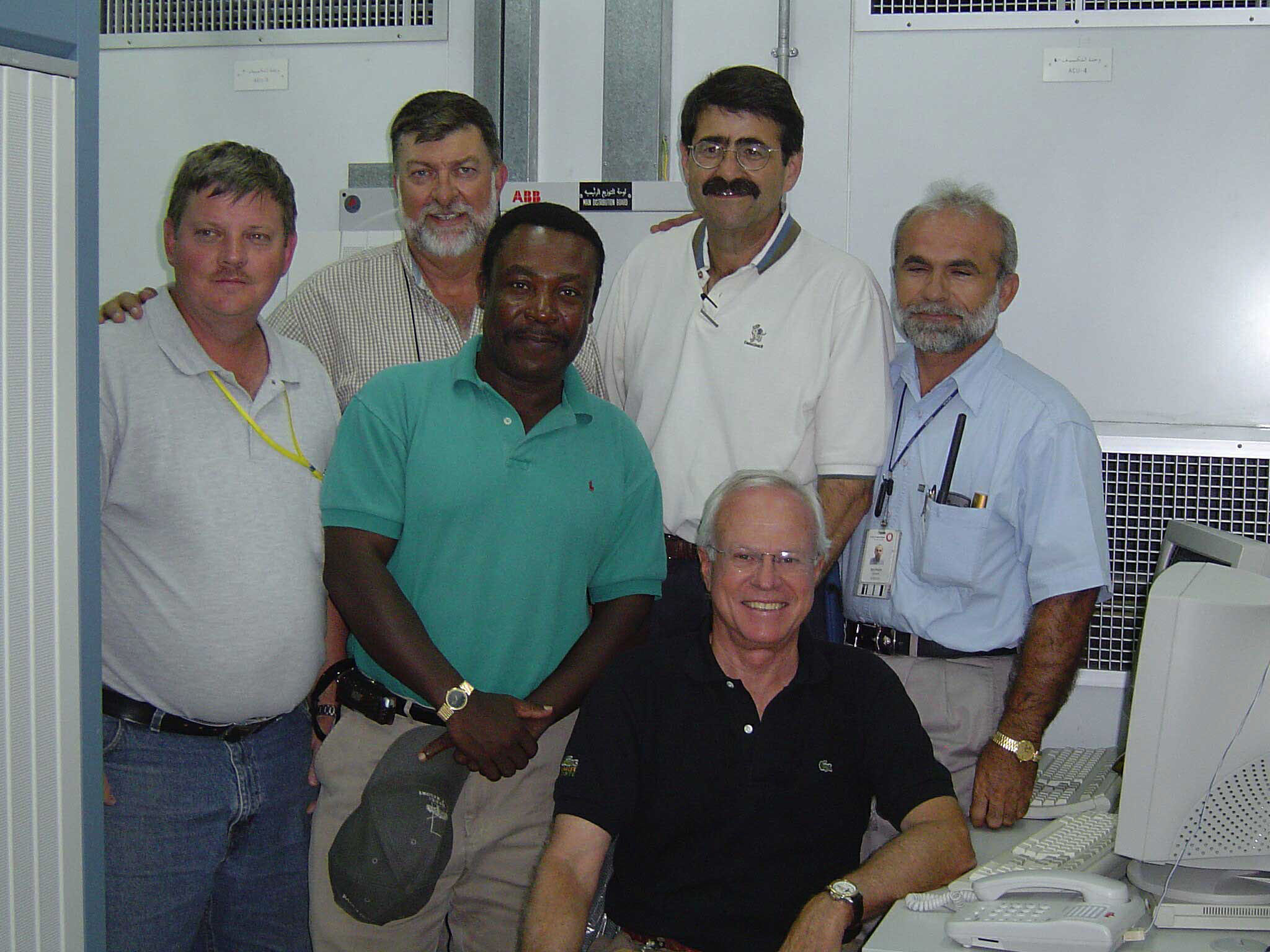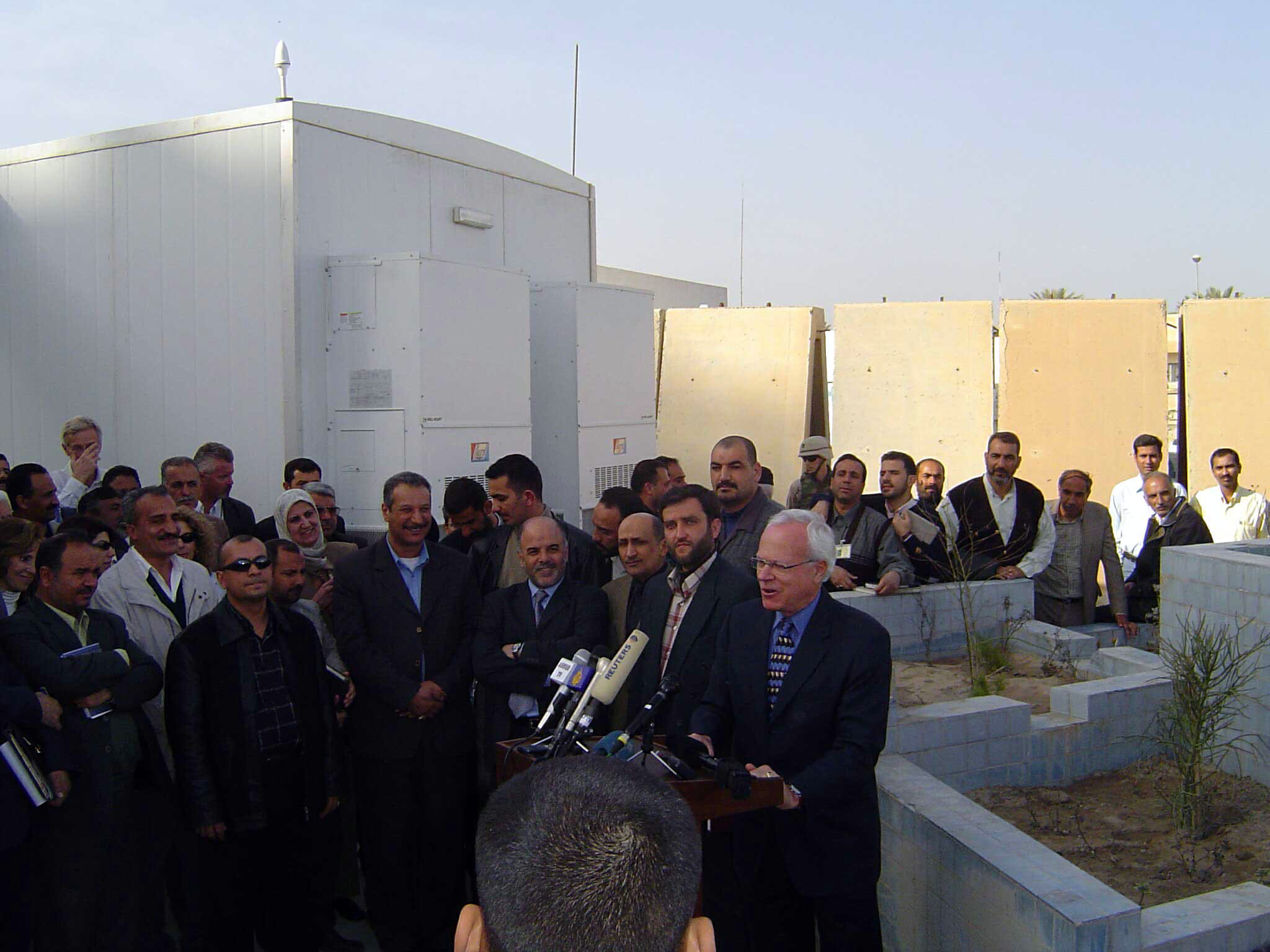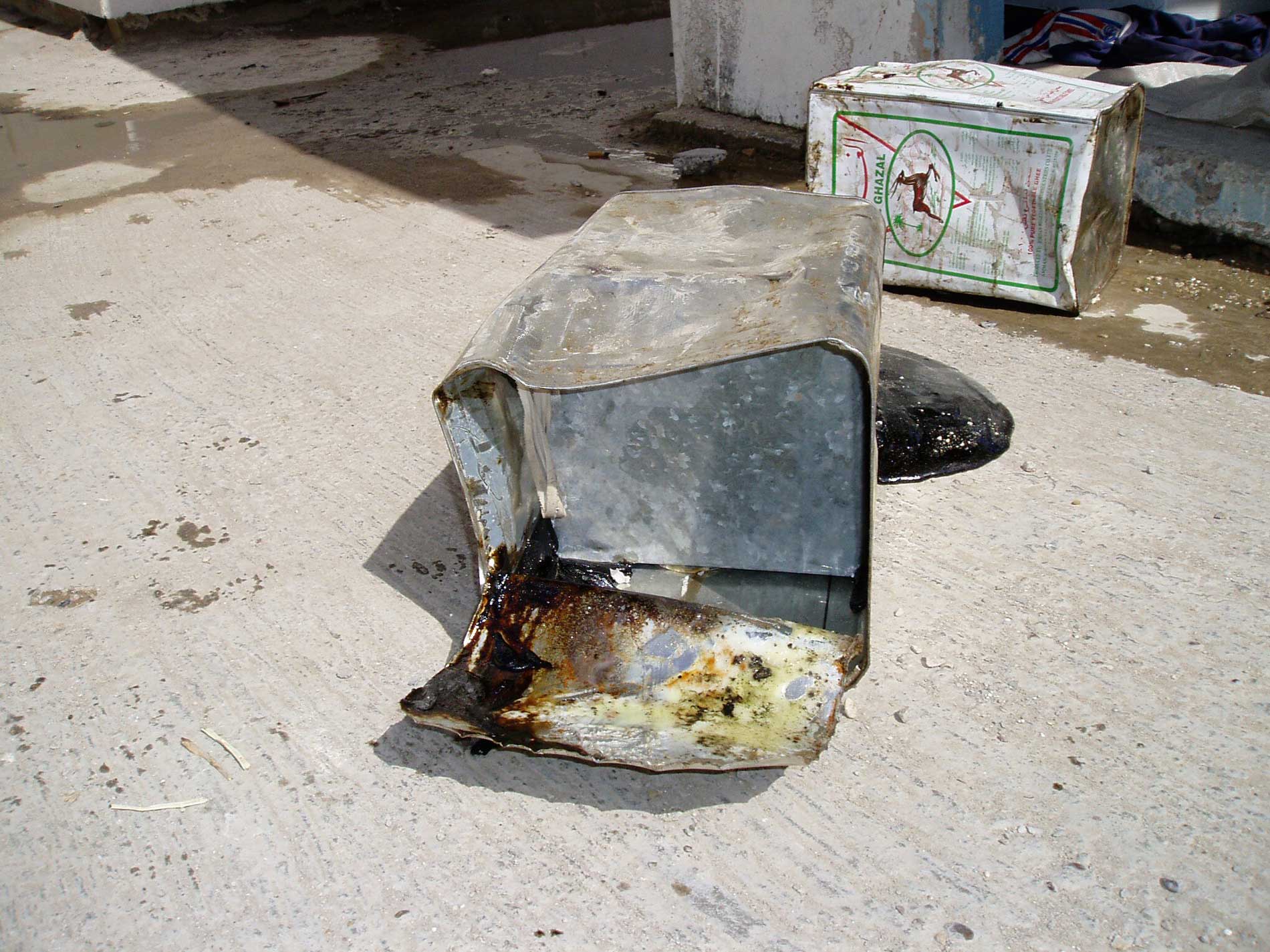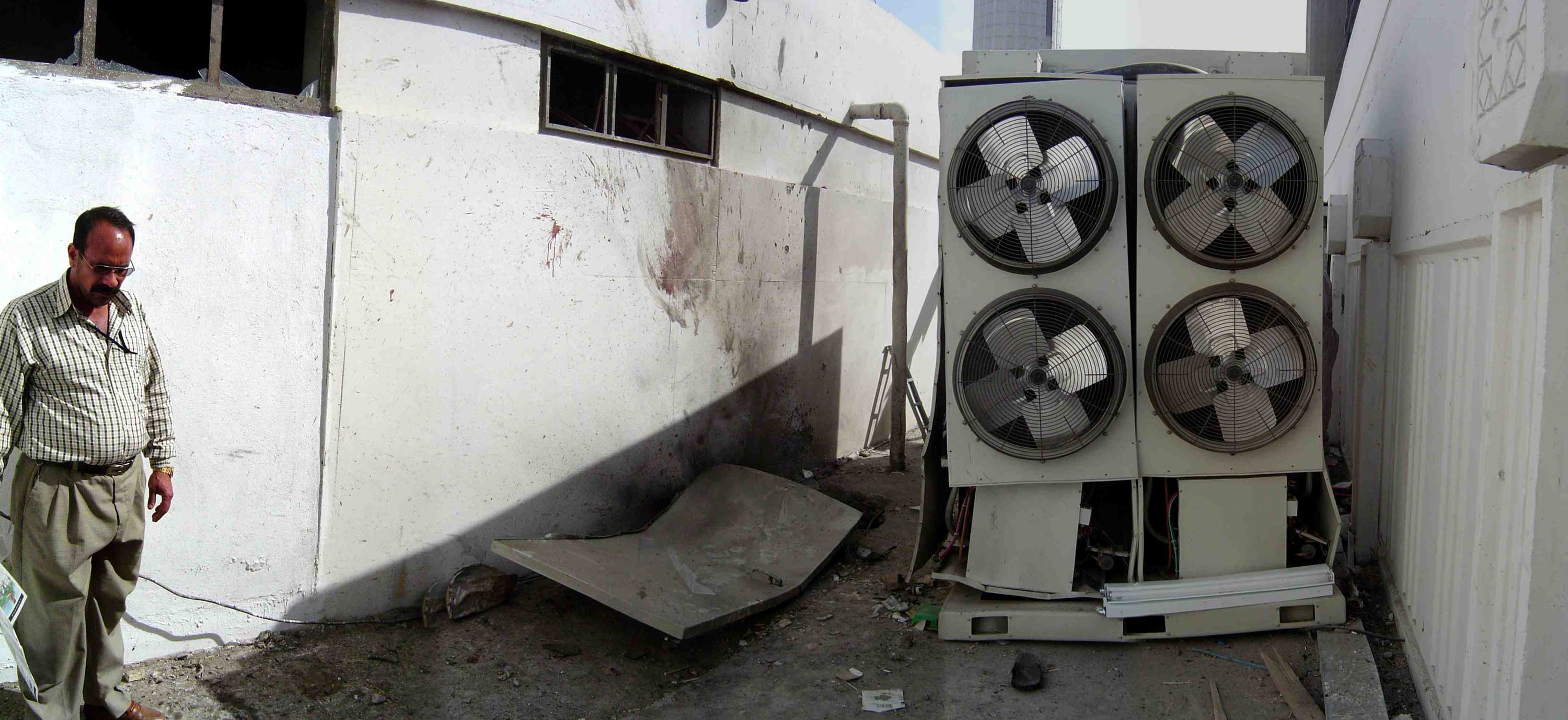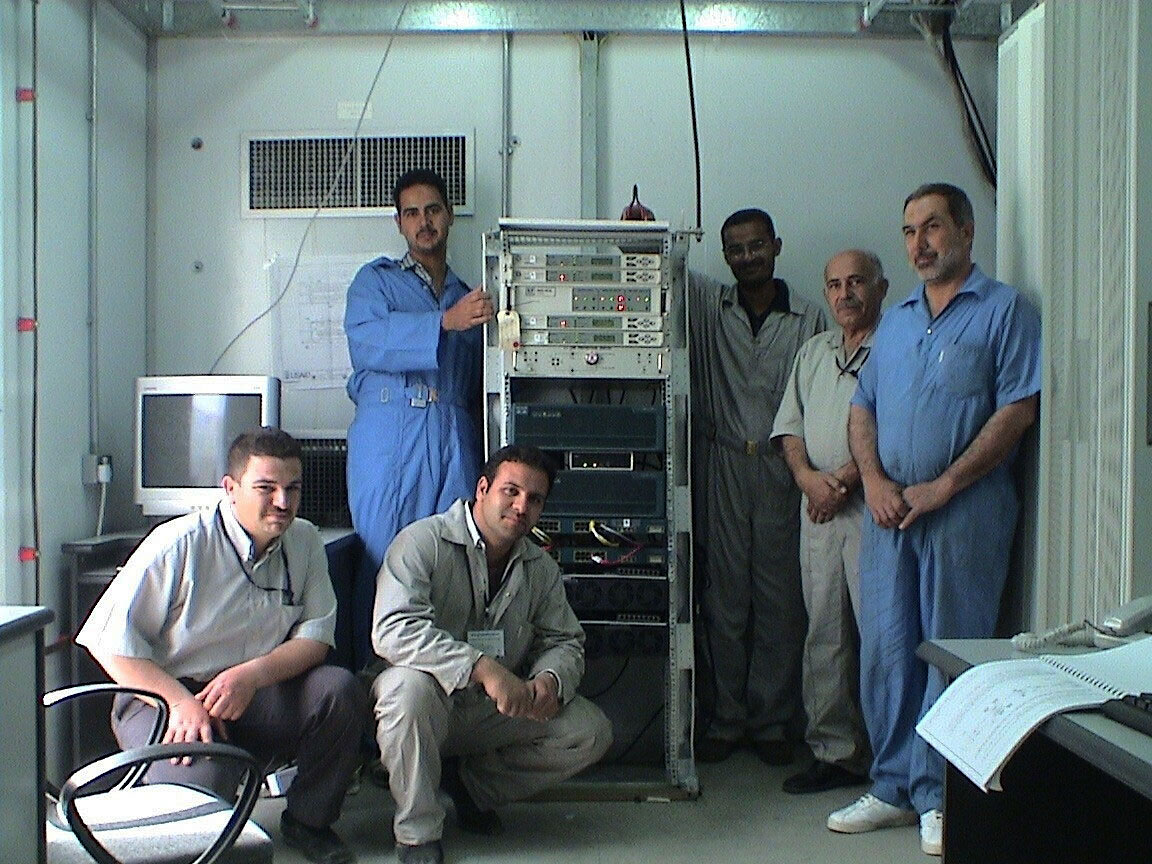Iraq Telecommunications Project and Sites
The Project Challenge - restore telephone service to the residents of the greater Baghdad area after all twelve exchanges were destroyed in the war. The five exchanges shown below pretty much show the before and after of what we did for all twelve exchanges. Since each exchange building was totally destroyed, we had to locate a place where we could create a new replacement. This was either on some available land nearby, or on the same building site after totally removing the remains/rubble of the previous building. Then, our process was fairly standard - we would locate all of the underground cables coming into (from all directions) the old exchange building, splice new cables onto the old ones, and route the new cables to the chosen location of the new exchange. The new exchanges were the latest technology Lucent switches, which were housed in portable containers. The switches were manufactured in Yugoslavia, the containers from Abu Dhabi, and everything assembled in Kuwait for final transport to Baghdad by truck. The satellite gateway system was manufactured by Globecom in the U.S. and airshipped to Kuwait for eventual assembly in Baghdad.
Sinek Exchange
The Sinek Exchange occupied an entire 12 story building in the downtown area. It is a landmark, and can be seen from almost anywhere in Baghdad. It was particularly notable for the chunk of missing structure, taken out by a tomahawk missle, which nearly toppled the building.
During the period of looting immediately after the war, a looter's welding tourch ignited something, resulting in a fire which burned for days, gutting the structure.
This is the public business area housed in a three story building attached to the front of the 12 story tower. The hole in the floor was caused by a bunker buster bomb that came vertically down through the roof and destroyed the basement that housed all of the switching equipment.
Locating the old cables was an arduous task. We had to tie into the old cables far enough away from the destroyed building to avoid working with damaged cables. These are 1800 pair copper cables about 3 inches in diameter.
Rubble and trash control became a full time battle. Every morning we would find our cable trenches filled with new trash.
For Sinek the closest new site we could find was behind this building located across the street from the Sinek tower. The building ahead is the Iraq School of Music, and was always full of interesting sounds - even some music. The site we chose is to the left and also behind the school. Some of our cable runs would be over half a kilometer long. Fortunately, we could use the existing cable tunnels that crossed under the road.
Ben and Salman look over the site.
Laborers open the cable tunnel under the road and work on the cable trenches in front of the music school.
Cable trenches under construction. These are concrete slabs with brick side walls, and eventually with precast concrete plank covers.
Container slabs and cable trenches are almost done. first of the new cables have been pulled to the site.
Hard working masons are building the cable splice chamber building (left), and generator building (right). A new wall around the site already completed.
Once the splice chamber building is done, splicers can begin the arduous task of splicing the main 3- inch cables to the smaller tip cables that run to the main switch frame.
Containers now in place and fully wired. All new masonry painted white. The small new buildings house gate house, toilets, and storage room. Cable wiring to the main frame and switch underway. Drive by shootings and grenade throwing during nights will require additional security barriers.
Now complete! An operator arrives for work, walking through the additional concrete barriers.
Completed complex from the east side.
And from the west. New corregated metal screening wall on the bridge prevents night shooting from cars on the bridge.
Adamiya Exchange
Now fully operational
Kadamiya Exchange
Salihya Exchange
Mamoun Exchange
The Telecommunications Tower and destroyed exchange building.
The exchange building was an eight story building before two tamahawk missles arrived
The interior structure was fully collapsed
The site we chose for our new exchange complex is to the left side of this photo, on the site of a former childrens' amusement park
Site cleared and ready for foundation slabs for the trailer complex.
Slabs now ready. The roof of the small building just beyond the two white vehicles will be the location for the new international satellite dish.
Preparing the roof for the dish.
Setting the four trailers to house two switches, the splicing main frame, and an office
Great Army protection
Satellite dish in place. The brains of the satellite communications system is housed in the metal building to the left.
Fully operational
Final site visit
Formal turnover ceremony on 26 February 2004, with The Iraq Minister of Telecommunications Dr. Haydar al-Abadi (third on my right with folded arms. He became the Prime Minister in September 2014), USAID, Bechtel, Lucent, Globecomm, and other subcontractors.
Several days later an Iraqi worker smuggled a bomb in the false bottom of this asphalt can and placed the bomb under the satellite building.
The bomb exploded prematurely and killed the bomber, but destroyed the satellite equipment.
Eleven days later this Globecomm crew had fully restored the satellite system using spare parts provided as part of their contract.
USAID Announces the Completion of Iraq Telephone Exchange Rehabilitation
WASHINGTON , DC 20523
PRESS OFFICE
http://www.usaid.gov
Press: (202) 712-4320
Public Information: (202) 712-4810
2004-012
FOR IMMEDIATE RELEASE
February 26, 2004
BAGHDAD , IRAQ - The U.S. Agency for International Development (USAID) and the Coalition Provisional Authority (CPA) today announced the integration of the 13 new switches and a new International Satellite Gateway with the 14 existing telephone switches of the Iraqi Telephone and Postal Company (ITPC) in Baghdad. The new switches and international gateway were installed by USAID partner Bechtel.
Before the conflict, 1.1 million Iraqis, half of which were in Baghdad, subscribed to the ITPC for landline telephone service. In Baghdad, 240,000 out of 540,000 telephone lines were out of service at 12 telephone exchange sites.
As part of the CPA overall Reconstruction Program, USAID and its implementing partner Bechtel restored the sites, which allow the ITPC to bring all telephone lines back into operation. Containerized, modern telephone switches were installed and are connected to and being monitored and controlled from the new Network Operations Center at Al Mamoun, the largest site in the country. The ITPC staff is connecting network wiring and programming subscriber numbers to allow final activation. Nearly 80% of individual subscriber lines have now been connected. All fully operational telephones nationwide can access the switch at Al Mamoun and the International Satellite Gateway. Once connected to the gateway, outbound international calls can be made using a prepaid phone card. Active subscribers are receiving inbound calls.
USAID and Bechtel collaborated closely with the ITPC on this project. ITPC crews performed much of the work including locating intact cable to which they spliced new cables and performed all cable splicing and wiring of the main distribution frames of the switches.
In addition to the exchange switches, USAID partner Bechtel is restoring portions of the main 2,000 kilometer, north-south fiber optic backbone connecting Dahuk in the far north to Umm Qasr in the extreme south. Connectivity between all cities north and south of Baghdad will deliver voice and data communications the country needs both for its immediate requirements and for future economic development.
In support of the Coalition Provisional Authority's objectives to restore essential services, USAID is allocating $50 million for telecommunications. For more information on CPA's and USAID's reconstruction efforts in Iraq including photos, please visit www.cpa-iraq.org and www.usaid.gov/iraq/.
The U.S. Agency for International Development has provided economic and humanitarian assistance worldwide for more than 40 years.
Background
The two Job Orders for Telecommunications services were received by Bechtel on 30 June 2003. The scopes of work for these as follows:
- JO 03-022, Restoration of Subscriber Services, was for two basic scopes: 1) restoration of the switches and subscriber service lost as a result of twelve telephone exchanges being destroyed in the war (included 12 subscriber switches and one transient switch), and 2) Installation of an international satellite gateway to be the primary gateway for the country.
- JO 03-023, Restoration of Terrestrial Fiber Optic Network, had the scope of restoring the entire 2000 km North-South fiber backbone.
Both JOs stipulated that the scope was only intended to duplicate pre-war capacity/capability.
Chronology of Events
-
30 June 03 – Job Orders 03-022 and 03-023 received from USAID.
-
7 July 03 – First site preparation work begun by the ITPC.
-
12 July 03 - RFP out for the switches manufacture and install.
-
7 July 03 - RFP out for the international satellite gateway.
-
28 July 03 - First major order placed for tools, equipment and materials for the ITPC (for both the switching network and for test and repair of the backbone).
-
20 Aug 03 - Contract for switches awarded to Lucent Technologies, Inc.
-
24 July 03 - Contract for the international satellite gateway awarded to Globecomm Systems, Inc.
-
20 August 03 – Audit of the North-West leg of the fiber backbone completed.
-
21 September – Audit of the North-East leg of the fiber backbone completed.
-
7 October 03 - First Main Distribution Frame (MDF) containers received in Baghdad from Lucent.
-
17 October 03 – First switches delivered to Baghdad.
-
23 October 03 – First international call made through the satellite gateway, class 5 switch and class 4 switch.
-
24 October 03 – Audit of the Southern loop of the fiber backbone completed.
-
9 December 03 – Satellite gateway system accepted for service.
-
12 December 03 – Final Lucent switch delivered to final site in Baghdad.
-
14 December 03 – First switch/MDF system accepted for service (Mamoun).
-
27 December 03 - Award of the DWDM equipment and installation contract to Nortel Networks for restoration of the South-West backbone.
-
26 January 04 – Final switch/MDF system accepted for service ( Samarra).
-
5 February 04 – Final acceptance of the entire switch and sonnet ring system.
-
26 February 04 – Formal acceptance ceremony of entire JO 03-022 project by the Minister of Communications Dr. Haydar al-Abadi, with speeches by the Minister, USAID (Tom Wheelock), and Bechtel (Beuby).
-
3 March 04 – Satellite Gateway container and equipment destroyed by a bomb at Mamoun, killing the bomber and injuring one subcontractor worker.
-
14 March 04 – Satellite Gateway emergency repairs completed, system fully operational.
-
31 May 04 – Globecomm completed the 6-month O&M period for the international satellite gateway.
-
6 June 04 - First Nortel DWDM equipment delivery (Mamoun).
-
31 July 04 – Lucent completes their 6-month O&M period for the switches network.

